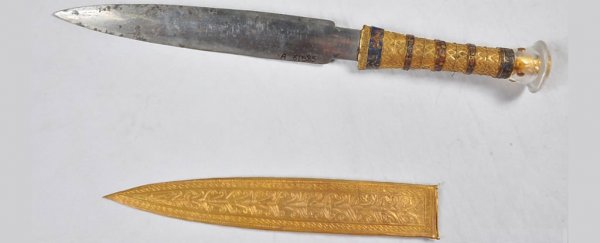According to a new study, it's possible that all iron-based weapons and tools of the Bronze Age were forged using metal salvaged from meteorites. The finding has given experts a better insight into how these tools were created before humans worked out how to produce iron from its ore.
While previous studies had found specific Bronze Age objects to be made from meteoric metal – like one of the daggers buried with King Tutankhamun – this latest research answers the question of just how widespread the practice was.
Albert Jambon, from the National Centre for Scientific Research (CNRS) in France, studied museum artefacts from Egypt, Turkey, Syria, and China, analysing them using an X-Ray Fluorescence Spectrometer to discover they all shared the same off-world origins.
"The present results complementing high quality analyses from the literature suggest that most or all irons from the Bronze Age are derived from meteoritic iron," writes Jambon in his published paper.
"The next step will be to determine where and when terrestrial iron smelting appeared for the first time."
Bronze was the metal of choice for tools, weapons, and jewellery during the Bronze Age – hence the era's name – which began around 3300 BCE. The alloy was durable and easily available, made by smelting copper and mixing it with tin and other metals.
The Iron Age that started some 2,000 years later gets its title because that's when we first learned to smelt iron from its ore, after discovering how to reach the very high temperatures needed for the process.
Historians have therefore always been puzzled by the presence of some iron weapons and tools dating back to the Bronze Age, which were highly valued as rarities at the time. Where was this iron coming from?
Key to answering that question is the fact that iron from meteorites falling to Earth contains a lot of nickel, whereas iron ore on the surface doesn't, because of the way nickel drifted towards the molten iron core of our planet during its formation.
With the help of the X-Ray Fluorescence Spectrometer, which uses X-rays to analyse the chemical composition of objects without touching them, Jambon studied museum exhibits including beads, a dagger, and a headrest.
Sure enough, meteoric iron high in nickel was found across the board. Iron deposited by meteorites would've been in a ready-to-use form for metalworkers, no smelting necessary.
This is more than just a cool story from the Bronze Age though – it's evidence that this kind of analysis can help narrow down just when and where we developed the technological know-how to start producing our own iron goods.
No one's quite sure when iron was smelted by human hand for the first time, but further research using these techniques and tools could be a big help in pinpointing the switch from meteoric iron to iron ore.
"The study emphasises the importance of analytical methods for properly studying the evolution of the use of metals and metal working technologies in our past cultures," writes Jambon.
The research has been published in the Journal of Archaeological Science.
